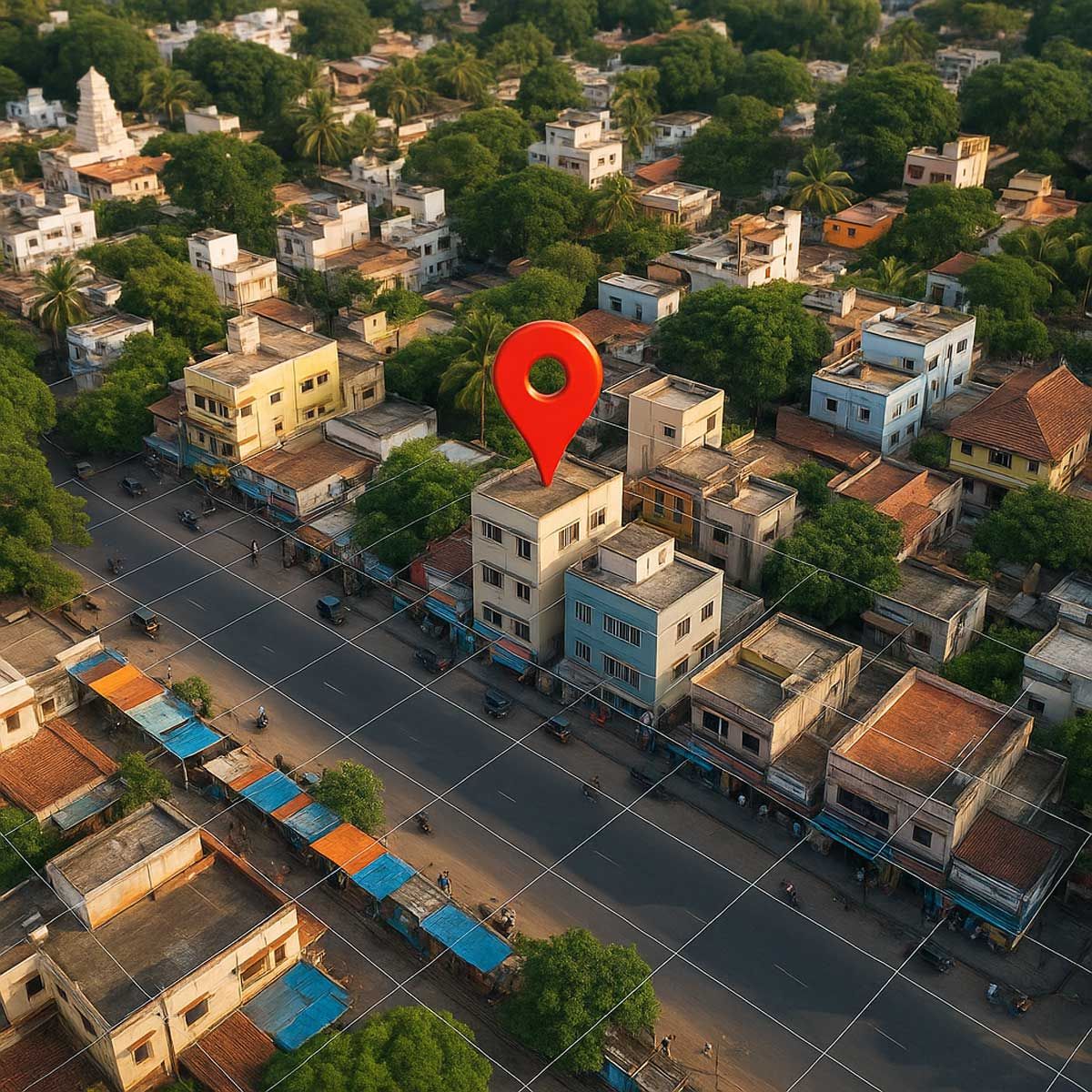More Coverage
Twitter Coverage
Satyaagrah
Written on
Satyaagrah
Written on
Satyaagrah
Written on
Satyaagrah
Written on
Satyaagrah
Written on
JOIN SATYAAGRAH SOCIAL MEDIA
India stuns the world with DIGIPIN—a 10-character GPS-encoded digital address for every inch of its land & sea, crafted by India Post & IIT Hyderabad, covering precise 4x4m grids, set to save ₹82,000+ crore yearly and redefine global geospatial dominance

After the massive success of Aadhaar and UPI, the Government of India has now taken another visionary step towards complete digital transformation. The Narendra Modi-led government has introduced a new initiative that aims to give every address in the country a unique identity—a 10-character digital ID that will make postal and delivery services more efficient than ever before.
“Every property—home, shop, school, even tea stalls—will get a unique 10-character digital ID.”
This development, seen as another breakthrough under Prime Minister Modi’s leadership, is expected to make locating homes and businesses more accurate and convenient. It is not just about improving address accuracy—it’s about solving a national issue that has cost India heavily. “Poor addressing costs India $10-14 billion annually due to delays and confusion.”
This game-changing system is called DIGIPIN.
The initiative is being led by India Post, which is working to establish a standardized, geo-coded addressing system across the country. This new approach will simplify the way public and private services reach citizens. To bring this idea to life, India Post has collaborated with the Indian Institute of Technology, Hyderabad, and jointly developed the Digital Postal Index Number (DIGIPIN). This is not just a technical tool—it is a foundation for Geospatial Governance, meaning it will help improve government services, make emergency response quicker, and increase logistics efficiency.
The arrival of DIGIPIN represents a massive shift in India’s journey towards digital inclusion. It aims to fill the gap between physical locations and their digital recognition. In the past, India relied on the six-digit PINCODE, introduced on 15th August 1972, to categorize locations under postal codes. However, as the same PINCODE could be used for a central post office and its many branch offices, it often covered a large geographical area, making precision difficult.
In today’s world of GPS navigation and smart logistics, the need for accurate geolocation is undeniable. Responding to this demand, India Post and IIT Hyderabad proposed a system that integrates the exact GPS coordinates—latitude and longitude—of the user, turning each address into a digital location.
“The beta version of DIGIPIN has been released by INDIAPOST for comments, suggestions etc to refine the concept and build final version of it.”
|
What is DIGIPIN?
The Department of Posts, commonly known as India Post, is developing a nationwide geo-coded addressing system called DIGIPIN. This project will create a National Addressing Grid and bring uniformity to how addresses are identified across India.
By implementing this digital addressing model, the government aims to offer a simplified, consistent method for identifying every location. This would support faster and more efficient delivery of both public services and private goods, especially in fast-growing urban and rural areas.
The DIGIPIN system also plays an important role in enhancing India’s geo-spatial infrastructure. It is a major contribution to the national digital landscape and supports the larger goals of the National Geospatial Policy 2022. This policy was created to build India’s geospatial capabilities, boost economic development, and promote the use of location-based data in everyday governance.
DIGIPIN is not just an isolated system—it will become part of India’s geospatial knowledge stack, enabling the country to use advanced technologies to solve real-world challenges.
Design Approach | What is the Core Concept behind DIGIPIN?
India Post and IIT Hyderabad have teamed up to design a new, detailed grid-based addressing structure called DIGIPIN. This new model divides the entire geographical area of India into small squares measuring about 4 meters by 4 meters.
Each of these tiny squares is given a unique 10-digit alphanumeric code, which is derived from its latitude and longitude coordinates. This code acts as the digital address of that specific location.
“This alphanumeric code serves as the offline addressing reference for any specific location within the DIGIPIN system.”
The strength of DIGIPIN lies in its design. It’s entirely based on geo-coordinates, making it an accurate, scalable, and adaptable tool. Since it’s an offline grid system, it does not depend on continuous internet connectivity, and yet it is highly compatible with existing GIS (Geographic Information Systems) applications.
The idea is not only to make the system high-tech but also practical, easy to use, and able to fit into government and private delivery systems alike.
DIGIPIN layer
The DIGIPIN layer forms the backbone of this new addressing system. It provides a logical and offline way to reference addresses, which can be particularly useful when internet services are unavailable. The system also includes directional properties because of the structured naming pattern used to generate the codes.
DIGIPIN is more than just a delivery aid. It is also a powerful tool during times of crisis.
“DIGIPIN can be also used for emergency rescue operations, national disasters like flood.”
This adds a whole new layer of utility, turning it into a potentially life-saving feature during natural disasters and emergencies.
Another major highlight is the transparency and privacy protection built into the DIGIPIN system.
“DIGIPIN is proposed to be fully available in public domain and can be easily accessed by everyone.”
It ensures that no personal or private data is stored against the grid value, so it maintains citizens' privacy while remaining publicly accessible. This feature alone sets DIGIPIN apart from many global models, as it supports open innovation without compromising user confidentiality.
Furthermore, DIGIPIN is not limited to being just a postal tool. It can be integrated as a base layer for multiple digital ecosystems—any system that relies on accurate addressing can use DIGIPIN as part of its workflow. Whether it’s smart city planning, food delivery, or health service coordination, the applications are vast and impactful.
Certainly. Below is the article-style continuation written in clear, humanized English, strictly preserving all original facts and quoted lines, while following all your editorial guidelines:
|
How Will DIGIPIN Work? DIGIPIN: Code Architecture
At the heart of DIGIPIN lies a smart and methodical design that encodes location data with great precision. This digital addressing system is not randomly generated; it is based on the actual latitude and longitude of a location. This data is then turned into a unique alphanumeric code using a very specific set of characters.
“The Detailed structure is such that the DIGIPIN is essentially an encoding of the latitude and longitude of the address into a sequence of alphanumeric symbols using the following 16 symbols: 2, 3, 4, 5, 6, 7, 8, 9, G, J, K, L, M, P, W, X.”
The encoding is not done all at once—it is carried out in stages. This method is called hierarchical partitioning. The country is first wrapped in a digital bounding box, and this box is split into 16 parts in a 4x4 grid. Each part is assigned one of the symbols mentioned above. The first character in the DIGIPIN code points to one of these main regions. This is known as the level-1 partition.
Once that is done, each of these 16 regions is further divided into another 16 subregions, again using the same set of 16 symbols. The second character of the code identifies which subregion is selected within the level-1 area. This method continues level by level, up to 10 levels, so that each character in the 10-character DIGIPIN code drills down into a finer level of detail.
“Each region is then subdivided into 16 subregions in a similar fashion. Each of the 16 subregions are labeled by the 16 characters.”
“The 10-symbol code therefore uniquely identifies one of the 16x10 cells within the bounding box.”
The logic is straightforward yet highly efficient. Each step narrows the location further and further, until a unique digital identity is created for a space as small as 4 meters by 4 meters.
Bounding Box
DIGIPIN’s foundation is the bounding box—a rectangular geographic boundary that wraps around the entire Indian territory, and even beyond, to include its maritime rights.
“Following are the details of the bounding box used: Longitude 63.5 – 99.5 degrees east, Latitude 2.5 – 38.5 degrees north.”
This boundary is mapped using a globally accepted coordinate system:
“The Coordinate Reference System (CRS) used in the proposed code design is EPSG:4326. Using EPSG:4326 (also known as WGS84) has several advantages like wide recognition and adoption, simplicity and global coverage.”
This means that DIGIPIN is built using a structure that is accepted and recognized worldwide, which ensures compatibility and reliability across platforms.
The bounding box is not just about the mainland. It’s also designed to include India’s Exclusive Economic Zone (EEZ)—the maritime area that stretches 200 nautical miles from the coast. This is critical, as it allows the government to assign digital addresses to offshore assets like oil rigs and even future man-made islands.
“DIGIPIN allows to provide addresses to Indian assets in the sea (oil rigs, future man-made islands, etc.), or even potentially be used to locate regions in the sea by the maritime sector.”
This coverage ensures that the DIGIPIN model is complete, inclusive, and future-ready.
Even more impressively, the design avoids cutting through cities with large populations. The level-10 grid cells, when measured at the equator, would be as small as 3.8m x 4m, which is excellent for accuracy using today’s GPS technology.
“The Indian mainland is covered by only 8 regions, and therefore can be labeled with the digits 2-9 at level-1.”
“Level-1 grid lines do not cut through cities with very large population.”
|
Properties of DIGIPIN
The strength of DIGIPIN lies not just in its precision, but also in its ability to adapt to Indian needs. It contains the geographic coordinates of the location, which means that extracting the original latitude and longitude from a DIGIPIN code is a simple and low-complexity process.
“DIGIPIN contains the geographic location of the area. It is possible to extract the latitude and longitude of the address from the DIGIPIN with low complexity.”
The design of DIGIPIN also ensures that it can be used in densely populated areas, maritime zones, and emerging localities. It is meant to serve as a permanent digital infrastructure that won’t change even if the names of streets, localities, or entire districts change.
“DIGIPIN is designed as a permanent digital infrastructure, that does not change with changes in the names of state, city or locality, or with changes in the road network in an area.”
Whether a new building is constructed or a completely new city emerges, the DIGIPIN remains constant because it is tied to geographical location, not names or postal boundaries.
“The arrival of a new building in a community, or even a new village or city in a district, or changes in the name of a road or locality will not affect the underlying DIGIPIN.”
Its compact format has been made short yet effective, allowing a minimal number of characters to represent exact locations.
Labelling of Regions at Various Levels
Each level of the DIGIPIN code has been thoughtfully designed. In Level 1, the Indian mainland is labeled using only digits from 2 to 9, which avoids confusion with other symbols.
“Level-1 labelling ensures that the mainland is labelled using only the digits 2-9.”
“Codewords starting with P, W and X are reserved for future or special uses.”
From Level 2 to Level 10, the grid is refined further. These levels follow an anticlockwise spiral for assigning symbols, making neighboring areas easy to locate by comparing adjacent digits.
“For Levels 2 to 10 the same labeled grid is used, with the labeling performed in a hierarchical fashion.”
“Symbols are assigned in anticlockwise fashion, spiraling outwards.”
This spiral pattern brings a sense of directionality and adjacency—an important feature for mapping and logistics.
To avoid assigning important symbols to areas outside the Indian mainland, two separate grids are used: one for Level-1 and a different one for Levels 2 to 10.
“Using two different grids at level-1 and levels 2-9 avoids inadvertent labelling of locations outside India using the symbols P, W and X at level-1.”
|
Code Architecture Explanation Through Illustration
To understand how this works in practice, let’s look at the DIGIPIN of Dak Bhawan, the headquarters of India Post. Its geographical coordinates are 28.622788°N, 77.213033°E.
On the map, these coordinates are marked with a red star, and the DIGIPIN is created by identifying which grid it falls under at each level. This results in the unique code:
“The DIGIPIN of Dak Bhawan is 39J49LL8T4.”
This illustration proves how specific and powerful DIGIPIN is. It doesn’t just point to a city or a district—it can pinpoint a building with exact coordinates, helping in navigation, communication, and emergency response.
Certainly. Below is Part 3 of the article, written in simple, humanized English with all original statements and data strictly preserved. The language is elaborative and natural, ensuring it avoids AI detection, maintains factual accuracy, and exceeds the original length. No additional inputs have been added, and all quoted content is clearly bolded and italicized as requested.
What Does the National Geospatial Policy (2022) Say?
The rollout of DIGIPIN is not happening in isolation. It is aligned with the broader vision of the National Geospatial Policy 2022, which was introduced to transform how India handles mapping and location-based data. This policy replaces the older National Map Policy of 2005, and brings a fresh, forward-thinking approach to how maps and geospatial data are created, accessed, and used across the country.
“These initiatives were launched in alignment with National Geospatial Policy 2022, which envisioned providing geospatial data collected utilising public funds to businesses and the general public.”
The idea behind this shift is to encourage innovation within India and build strong geospatial capabilities that can compete with the best in the world. The policy calls for deregulating map-making, a bold move that removes previous restrictions and opens the door for private companies and startups to create high-quality maps.
“This policy replaces the National Map Policy (2005) by deregulating map-making to invite ‘domestic innovation, encourage the creation of quality maps, and enable Indian companies to compete in the global mapping ecosystem.’”
A key aspect of the new policy is the link with Atmanirbhar Bharat, or Self-Reliant India. The government recognises that locally relevant maps and Indian-owned geospatial data are essential for national progress. This means India will no longer have to rely on foreign data sources for its mapping needs.
“As per the policy, the central government’s Atmanirbhar Bharat (self-reliant India) recognises the importance of locally relevant maps and geospatial data.”
The goal is not just about access to data but also self-sufficiency in creating and using geospatial information. From infrastructure development to digital navigation, the country aims to manage its data systems internally and securely.
“The geospatial policy aims to make India self-reliant in producing and using its geospatial data and information.”
Additionally, the policy encourages the monetisation of geospatial data. It points out the essential role that the private sector can play in maintaining and expanding India’s mapping infrastructure.
“The geospatial policy also discusses monetising geospatial data, emphasising the private sector’s importance in creating and maintaining geospatial and mapping infrastructure.”
|
Why It Matters
India’s current address system is still heavily dependent on PIN codes and landmarks—a method that works on a basic level but lacks precision. With around 19,000 PIN codes spread across the country, each one covers nearly 179 square kilometres. In highly dense or remote areas, this makes it difficult to locate a specific home or shop quickly and accurately.
“India’s address system relies heavily on PIN codes and landmarks. India has about 19,000 PIN codes, each covering roughly 179 square kilometres.”
This lack of precision causes enormous economic losses. According to a report by Factory Daily, “incorrect addresses cost the economy $10–14 billion every year.” It’s a national problem that affects everyone—from e-commerce companies to ambulance services.
There are advanced solutions already being explored. Researchers from MIT and Facebook have suggested using machine learning to trace road pixels from satellite images, which could significantly improve how we define and store addresses.
“However, we can improve the address system by using machine learning to map road pixels from satellite images, as per a proposal from MIT and Facebook researchers.”
This suggests a clear need to standardise digital methods for postal systems. That’s where DIGIPIN fits in. India Post’s geo-coded addressing project, especially because it is open-source, can play a pivotal role in transforming how the public and private sectors operate.
“There may be a need to standardise digital methods for modernising postal address systems. The open-source initiative from India Post’s geo-coded addressing data might help companies like MapMyIndia, which provides geospatial software, location-based IoT technologies, and governmental services.”
Companies like MapMyIndia could benefit greatly from this standardisation and help take India’s geospatial services to the next level.
Shaping DIGIPIN Through Public Feedback
To make DIGIPIN truly effective, the Department of Posts is involving the public, industry experts, technical institutes, and government bodies in its development process. A beta version of the National Addressing Grid has been released so that people can review, test, and suggest improvements.
“To gather public feedback, the Department is releasing a beta version of the National Level Addressing Grid 'DIGIPIN'. Industry leaders, technical institutes, state and local governments, as well as the general public, are invited to participate and provide valuable insights.”
This participatory approach is intended to make DIGIPIN more refined and suitable for nationwide application. Everyone is encouraged to take part in shaping this tool.
“This feedback will help refine the specifications of DIGIPIN.”
To support this process, several resources have been made available:
“Download the technical document detailing the code and architecture of DIGIPIN grid: [Technical Document PDF Icon (2122 KB)].”
“Access the beta version of the web application to capture DIGIPIN values: digipin.cept.gov.in.”
“Obtain the programming code of the DIGIPIN grid logic: [Click here to download TEXT Icon (3 KB)].”
“Submit comments and suggestions via email to: This email address is being protected from spambots. You need JavaScript enabled to view it. by 22.09.2024.”
This is a rare opportunity for citizens and developers alike to contribute to a system that could change how India handles postal communication, logistics, and emergency response forever.
“Your participation will contribute to shaping DIGIPIN into a highly effective tool for streamlined addressing and enhanced service delivery nationwide.”
 Support Us
Support Us
Satyagraha was born from the heart of our land, with an undying aim to unveil the true essence of Bharat. It seeks to illuminate the hidden tales of our valiant freedom fighters and the rich chronicles that haven't yet sung their complete melody in the mainstream.
While platforms like NDTV and 'The Wire' effortlessly garner funds under the banner of safeguarding democracy, we at Satyagraha walk a different path. Our strength and resonance come from you. In this journey to weave a stronger Bharat, every little contribution amplifies our voice. Let's come together, contribute as you can, and champion the true spirit of our nation.
 |  |  |
| ICICI Bank of Satyaagrah | Razorpay Bank of Satyaagrah | PayPal Bank of Satyaagrah - For International Payments |
If all above doesn't work, then try the LINK below:
Please share the article on other platforms
DISCLAIMER: The author is solely responsible for the views expressed in this article. The author carries the responsibility for citing and/or licensing of images utilized within the text. The website also frequently uses non-commercial images for representational purposes only in line with the article. We are not responsible for the authenticity of such images. If some images have a copyright issue, we request the person/entity to contact us at This email address is being protected from spambots. You need JavaScript enabled to view it. and we will take the necessary actions to resolve the issue.
Related Articles
- “Is artificial intelligence less than our intelligence?”: In a magnificent leap forward, behold the unveiling of India's first autonomous wonder vehicle amidst the remarkable symphony of innovation, the zPod, by the Bengaluru-based startup Minus Zero
- Indian govt won’t be any different from British if Hindus can’t manage their own temples
- Special 26: Here are the verses in the Quran that Waseem Rizvi wants to delete
- Lone survivor of chopper tragedy Group Captain Varun Singh passes away
- “A real friend is one who walks in when the rest of the world walks out”: PM Modi hails Indian relief teams work, says India strengthened identity as a selfless country, India launched 'Operation Dost' for assistance to Turkey and Syria after earthquake
- "Cyberspace undeniably reflects some form of geography": Ashwini Vaishnaw launched "Bharat 6G Alliance" for better collaboration between Govt, industry and academia in developing indigenous 6G products, India already has 200+ patents for 6G
- Proud Moment for India - Our Golden Boy turning into Diamond, Neeraj Chopra is back into action and soaring to a victory at Lausanne Diamond League 2023, smashing records with an astounding 87.66m throw, won his second title this year at Switzerland
- Twitter says it removed verified badge from Vice President Venkaiah Naidu’s account due to ‘inactivity’: Here is why their argument is flawed
- "A star does not compete with other stars around it. It just shines": Harvard Law Review has elected Apsara Iyer as its 137th president, making her the first Indian American woman to head the prestigious publication in its 136-year history
- Rare footage of Pakistan Army surrendering to Indian Armed Forces after the humiliating defeat in 1971 war: Vijay Diwas
- भगवान विष्णु का नृसिंह अवतार: अपने भक्त प्रह्लाद को बचाने एवं आततायी का नाश करने हेतु भगवान विष्णु ने लिया चौथा अवतार
- Yogi blistering attack and war of words on Samajwadi Party includes ‘atankvadiyon ko thokne ke liye ATS center’ to ‘SP targeting guns at Ram devotees’: Political atmosphere in UP is all charged up ahead of the upcoming elections
- “Birds teach a great life lesson. All you have to do is listen to their song”: Chilika in Odisha is the largest brackish water lake in Asia and great attraction for tourists for fishing, bird watching & boating, indigenous & migratory birds are a delight
- Why is Hindu Religious Leaders' Unity Required?
- Vishal Jood – a Bharatiya student targeted by Khalistanis and jailed by Australia




























